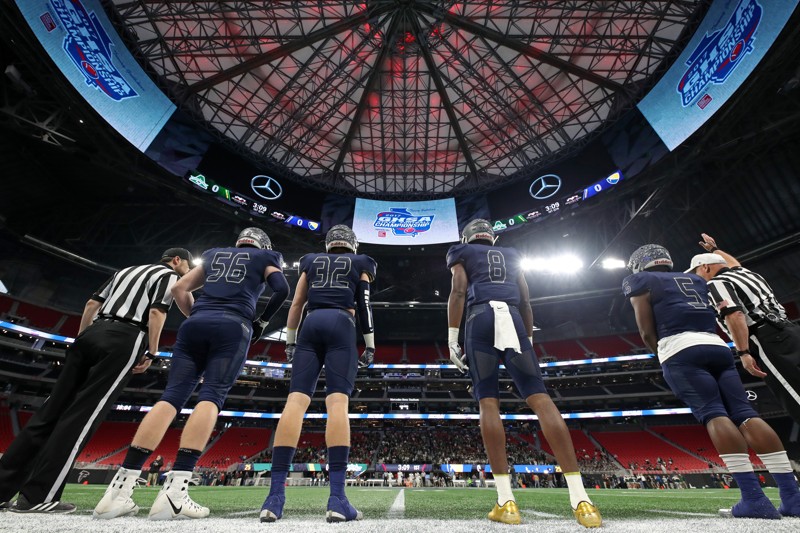
When the 2017-18 school year concludes later this month, it will mark the midpoint of the GHSA’s four-year reclassification cycle that is used to assign and place the state’s 450-plus teams into their respective regions. Assigning regions is a difficult task and the goal of the four-year model was to make it easier. The GHSA office was strained in the two-year system that had been used for decades, with its executive committee and the separate appeals and reclassification committees all frenetically working at once. The four-year approach was more practical and could provide regions with twice the permanence than the two-year arrangement could.
This change was first introduced at the start of the 2010-11 school year and included a two-year adjustment period. Every school in the state would be required to submit their FTE (Full-time equivalency) enrollment numbers at the two-year mark, but only the schools with exceptional changes in their student populations (a 20 percent increase or decrease) would be affected. This was a significant detail in the new system, because only a handful of schools would be affected every two years, rather than having dozens of schools crossing over.
Unbeknownst to them, the four-year cycle was just the beginning of new changes to be made. Much bigger, and difficult decisions were hanging just around the corner and the GHSA was about to enter one of the most important chapters in its history, ultimately restructuring the landscape into what it is today.
CLASS WARFARE
When the first two-year adjustment period arrived, reclassification took a back seat to a proposal that sparked discussions that nearly split the state in half. In March of 2011, the GHSA’s reclassification committee narrowly voted (7-to-5) in favor of a 4/8 reclassification plan, that would divide the state into four classifications during the regular season and eight for the state playoffs. The vote approved the recommendation, which was made by Charlton County athletics director Jesse Crews, to go in front of the full 50-member committee for a final stamp of approval. But this is where things really got complicated.
A six-class plan, proposed by Dave Hunter, was brought up and the committee began to weigh the pros and cons of the two plans; two members even jettisoned their positions to take the other side by the end. Additionally, Lincoln County head coach Larry Campbell voiced that private schools should be forced to play up a classification if they have students from outside their service area. In football, 11 of the past 13 Class A state champs had been won by public schools at the time, but the sourness between public and private schools extended to basketball and beyond with other sports, and had been testing the very fabric of the Association for years. Knowing this couldn’t be ignored, a vote was made to form an ad hoc committee with various reps from each side of the table. This group would have a chance to present their own case to the executive committee, which now wouldn’t meet until May. With so much indecision already with the 4/8 vs. six-class plans, plus a situation that was progressively getting more complicated, some saw pushing the decision back to May as just prolonging the agony.
Nonetheless, Hunter’s six-class plan, which had seemed dead in March, was passed with an even more narrow 26-24 vote on May 10, 2011. The GHSA was going to expand to a sixth classification starting in 2012-13 and Class A would be divided into separate Class A-Public and Class A-Private playoffs for the first time.
The effects of the decision were unmistakable. The GHSA had crowned 294 different schools football state champs in its 64 previous seasons, but in the first two years of the new structure, half (Norcross, Gainesville, Jefferson, ELCA, Aquinas, Creekside, Marion County) of the 14 football state champions won titles for the first time in their school’s history. More teams were making the playoffs, region sizes were made smaller, and the competition was as healthy as it had been, if not better. Still, there was room for improvement. The biggest schools in the highest classification could have nearly double the enrollment of the schools on the lower end, and the private school, city school debate was yet to be fully addressed.
No side would end up getting everything they wanted, and some were on sides of entirely different fences, but in August of 2015, the improvements the state had made since the 2011 meetings were apparent. A much more unanimous 47-10 vote approved the addition of a seventh classification, as well as a formula for private and city schools that would be adopted into the region alignment process for the first time in state history. If the percentage of students attending a school from outside its attendance zone exceeds three (3%) percent of the FTE count, then that school would be bumped up a classification. It was considered one of the fairest and balanced proposals in years and it was the product of 12 separate proposals that had been thoughtfully mended together.
Growing to seven classifications, however, once again decreased the size of the regions. The changes seen in Georgia’s highest classification in the past decade are dramatic, especially when it comes to football’s 10-game regular-season schedule (see below).
Percentage of non-region schedule in Georgia’s largest classification
2008-09 19.2%
2010-11 33.3%
2012-13 29.8%
2014-15 28.9%
2016-18 48.8%
When all the classes are combined; approximately 35% of the football schedule will be non-region games in this new structure: Class 7A (48.8%), Class 6A (33.1%), Class 5A (37.1%), Class 4A (40%), Class 3A (36.8%), Class 2A (34.6%), Class A (23.6%).
It’s hard to say what this many non-region games will mean, or if it means anything at all, other than more teams making the postseason. But one thing is for sure, coaches will do what they can to take advantage of it. Colquitt County, which has won 12 of the 16 road playoff games they’ve had against Gwinnett County programs over the last eight seasons, can continue to schedule Atlanta trips during the regular season to prepare for their ultimate goal. Reversely, Gwinnett-based Parkview, can host Lowndes and take a trip down to Tift County in non-region play, and better prepare them for their own difficult region like they are doing this upcoming season..
Football has long preached that every Friday night matters, and they obviously do, just not equally. More non-region games is allowing teams to take a more patient approach to their season’s goals. Non-region games can be used as a tool to create depth for late in the season, with no consequence on the standings. There is more room for cross-state showcases like the many planned for this upcoming season.
St. Pius is a prime example of the difference between region and non-region success. The Golden Lions always schedule difficult non-region games and they haven’t won one since 2013, giving them a 15-game non-region losing streak to open next season. Still, in region action, they’ve rattled off a 23-3 record, reached a final, semifinal and quarterfinal in the same span.
The landscape is going to continue to change, new schools will join the GHSA and school districts will change too. Schools like Buford have seen their population skyrocket over the last several years and all of Forsyth County is growing like wildfire.
It’s worth appreciating, however, that this is the calmest mid-cycle adjustment period since the introduction of the four-year cycle.











































